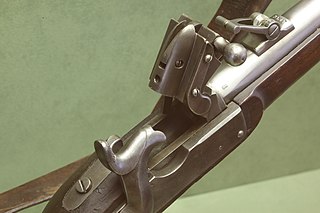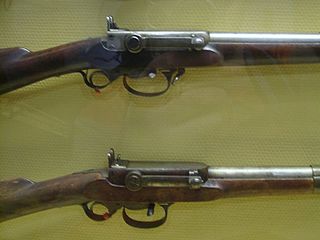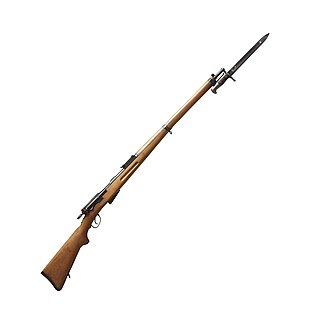 W
WThe 1792 contract rifle is not a specific model of gun, rather it is a modern way to categorize a collection of rifles bought by the United States government in that year. United States 1792 contract rifles are Pennsylvania-Kentucky Rifles with a 42-inch octagon barrel in .49 caliber, with a patch box built into the buttstock. What distinguishes them from civilian rifles is that they were bought by the government under military contract.
 W
WThe Albini rifle was a single-shot 11mm rifle adopted by Belgium in 1867. The action on the Albini rifle was designed by Italian naval officer Augusto Albini and was perfected by an English gunsmith, Francis Braendlin. Initially, there were delays and problems with its delivery as the rifle seemed to have extractor issues and the Terssen rifle was adopted as a temporary measure. But once the problem was fixed and the availability of Albinis increased, Terssens were eventually withdrawn from service. The Albini rifles were eventually replaced by M1870 Belgian Comblain rifles beginning in the 1870s.
 W
WThe Berthier rifles and carbines were a family of bolt-action small arms in 8mm Lebel, used in the French Army from the 1890s to the beginning of World War II (1940).
 W
WThe carabine à tige was a type of black-powder, muzzle-loading rifle invented by Louis-Etienne de Thouvenin. The method was an improvement of the invention of another Frenchman, Henri-Gustave Delvigne. Delvigne had developed chambered carbines and rampart rifle-muskets so that when forced against the chamber rim by ramming, the bullet would become deformed and flatten, so as to expand in diameter against the inside of the bore, allowing the bullet to press against the rifling grooves. When fired, the bullet accompanied the rifling and spun. This was an early attempt to work around one of the greatest hindrances to the use of military rifles; in order for a rifle to impart the proper spin to a projectile, the projectile must fit snugly inside the barrel to engage the rifling grooves. The problem, however, was that the black powder used at that time would quickly produce a thick layer residue of fouling. After only three or four shots, a typical rifle would be impossible to reload without using a mallet to force the bullet down the fouled barrel. Delvigne's design addressed this problem by introducing a projectile that was smaller than the bore of the barrel which after loading could then be struck with a ramrod. With three strokes of the ramrod, the bullet would become deformed and flatten, so as to expand in diameter against the inside of the bore, allowing the bullet to press against the rifling grooves. When fired, the bullet would accompany the rifling and spin. This improvement preserved accuracy while reducing the time required for reloading which would otherwise have been necessitated by the heavy fouling.
 W
WThe Chassepot, officially known as Fusil modèle 1866, was a bolt action military breechloading rifle. It is famous for having been the arm of the French forces in the Franco-Prussian War of 1870–1871. It replaced an assortment of Minié muzzleloading rifles, many of which were converted in 1864 to breech loading. An improvement to existing military rifles in 1866, the Chassepot marked the commencement of the era of modern bolt action, breech-loading military rifles. The Gras rifle was an adaption of the Chassepot designed to fire metallic cartridges introduced in 1874.
 W
WThe Dreyse needle-gun was a military breechloading rifle. It is famous for having been the main infantry weapon of the Prussians in the Wars of German Unification. It was accepted for service in 1841 as the "leichtes Perkussionsgewehr Modell 1841"("light percussion rifle Model 1841"), with the name chosen to hide the nature of the new weapon. The name "Zündnadelgewehr"/"needle-gun" comes from its needle-like firing pin, which passed through the paper cartridge case to strike a percussion cap at the bullet base. The Dreyse rifle was also the first breech-loading rifle to use the bolt action to open and close the chamber, executed by turning and pulling a bolt handle. It has a rate of fire of about 6 rounds per minute.
 W
WThe Farquharson Rifle is a single-shot hammerless falling-block action rifle designed and patented by John Farquharson, of Daldhu, Scotland in 1872. George Gibbs, a gun maker in Bristol, became a co-owner of the Farquharson patent in 1875 and was the sole maker of Farquharson rifles until the patent expired. Fewer than 1,000 Gibbs-Farquharson rifles were made, the last one being delivered in 1910.
 W
WThe Gallager carbine is an American black powder breechloading rifle produced in the American Civil War.
 W
WThe Gewehr 88 was a late 19th-century German bolt action rifle, adopted in 1888.
 W
WThe Type 88, sometimes known as "Hanyang 88" and Hanyang Zao, is a Chinese-made bolt-action rifle, based on the German Gewehr 88. It was adopted by the Qing Dynasty towards the end of the 19th century and was a standard Chinese rifle, being used by multiple factions and formations, until the end of the Chinese Civil War.
 W
WThe Hawken rifle is a muzzle-loading rifle built by the Hawken brothers that was used on the prairies and in the Rocky Mountains of the United States during the early frontier days. It has become synonymous with the "plains rifle", the buffalo gun, and the fur trapper's gun. Developed in the 1820s, it was eventually displaced by breechloaders and lever-action rifles which flourished after the Civil War.
 W
WThe Infanteriegewehr Modell 1842 was one of the first standardised service rifles used by the Swiss armed forces. It was introduced in 1842 as a result of a decision by the authorities of the Old Swiss Confederacy to standardise the weapons of the then still separate armies of the Swiss Cantons.
 W
WThe Jarmann M1884 is a Norwegian bolt-action repeating rifle designed in 1878 adopted in 1884. The Jarmann's adoption, and subsequent modifications, turned the Norwegian Army from a fighting force armed with single-shot black-powder weapons into a force armed with modern repeating weapons firing smokeless ammunition. Several thousand were manufactured to equip the Norwegian Armed Forces in the 1880s, and it also saw some, though very limited, use in Sweden. The design is unique, and was the brainchild of Norwegian engineer Jacob Smith Jarmann. After the design had been phased out of the Norwegian Army, a number of the weapons were rebuilt as harpoon guns.
 W
WThe Kammerlader, or "chamber loader", was the first Norwegian breech-loading rifle, and among the first breech loaders adopted for use by an armed force anywhere in the world. A single-shot black-powder rifle, the kammerlader was operated with a crank mounted on the side of the receiver. This made it much quicker and easier to load than the weapons previously used. Kammerladers quickly gained a reputation for being fast and accurate rifles, and would have been a deadly weapon against massed ranks of infantry.
 W
WThe Krag–Jørgensen is a repeating bolt action rifle designed by the Norwegians Ole Herman Johannes Krag and Erik Jørgensen in the late 19th century. It was adopted as a standard arm by Norway, Denmark, and the United States. About 300 were delivered to Boer forces of the South African Republic.
 W
WA Kropatschek is any variant of a rifle designed by Alfred von Kropatschek. Kropatschek's rifles used a tubular magazine of his design, of the same type used in the Japanese Murata Type 22 and the German Mauser Gewehr 1871/84. While designed for black powder, the Kropatschek action proved to be strong enough to handle smokeless powder.
 W
WThe Lebel Model 1886 rifle also known as the "Fusil Mle 1886 M93", after a bolt modification was added in 1893, is an 8 mm bolt action infantry rifle that entered service in the French Army in 1887. It is a repeating rifle that can hold eight rounds in its forestock tube magazine, one round in the transporter plus one round in the chamber. The Lebel rifle has the distinction of being the first military firearm to use smokeless powder ammunition. The new propellant powder, "Poudre B," was nitrocellulose-based and had been invented in 1884 by French chemist Paul Vieille. Lieutenant Colonel Nicolas Lebel contributed a flat nosed 8 mm full metal jacket bullet. Twelve years later, in 1898, a solid brass pointed (spitzer) and boat-tail bullet called "Balle D" was retained for all 8mm Lebel ammunition. Each case was protected against accidental percussion inside the tube magazine by a primer cover and by a circular groove around the primer cup which caught the tip of the following pointed bullet. Featuring an oversized bolt with front locking lugs and a massive receiver, the Lebel rifle was a durable design capable of long range performance. In spite of early obsolete features, such as its tube magazine and the shape of 8mm Lebel rimmed ammunition, the Lebel rifle remained the basic weapon of French infantry during World War I (1914–1918). Altogether, 3.45 million Lebel rifles were produced by the three French state factories between 1887 and 1916.
 W
WThe Lee–Metford rifle was a bolt action British army service rifle, combining James Paris Lee's rear-locking bolt system and detachable magazine with an innovative seven groove rifled barrel designed by William Ellis Metford. It replaced the Martini–Henry rifle in 1888, following nine years of development and trials, but remained in service for only a short time until replaced by the similar Lee–Enfield.
 W
WThe long rifle, also known as longrifle, Kentucky rifle, Pennsylvania rifle, or American longrifle, was one of the first commonly used rifles for hunting and warfare. It is characterized by an unusually long barrel, a development in American rifles that was uncommon in European rifles of the same period.
 W
WThe M1819 Hall rifle was a single-shot breech-loading rifle designed by John Hancock Hall, patented on May 21, 1811, and adopted by the U.S. Army in 1819. It was preceded by the Harpers Ferry M1803. It used a pivoting chamber breech design and was made with either flintlock or percussion cap ignition systems. The years of production were from the 1820s to the 1840s at the Harpers Ferry Arsenal. This was the first breech-loading rifle to be adopted in large numbers by any nation's army, but not the first breech-loading military rifle – the Ferguson rifle was used briefly by the British Army in the American Revolutionary War. The Hall rifle remained overshadowed by common muskets and muzzleloading rifles which were still prevalent until the Civil War. The early flintlocks were mostly converted to percussion ignition.
 W
WThe M1841 Mississippi rifle is a muzzle-loading percussion rifle used in the Mexican–American War and the American Civil War.
 W
WThe M1867 Russian Krnka was a breech loading conversion of the muzzle-loading Model 1857 Six Line rifle musket designed by Austro-Hungarian arms maker, Sylvester Krnka.
 W
WThe M1867 Werndl–Holub was a single-shot breechloading rifle adopted by the Austro-Hungarian army on 28 July 1867. It replaced the Wänzl breechloader conversion of the muzzle-loading Lorenz rifle. Josef Werndl (1831–1889) and Karel Holub (1830–1903) designed and patented their rifle; Werndl later bought out all the rights, but was involved in name only.
 W
WThe M1870 Belgian Comblain was a falling-block rifle invented by Hubert-Joseph Comblain of Liège, Belgium and produced in several variants known as the Brazilian, Chilean or Belgian Comblain.
 W
WThe M1870 Vetterli was the Italian service rifle from 1870-1887, when it was gradually replaced with the M1870/87 Italian Vetterli-Vitali variant. The M1870 was a single-shot bolt action rifle chambered for the 10.4mm Vetterli centrefire cartridge, at first loaded with black powder and later with smokeless powder. The M1870 Italian Vetterli was based upon the M1870 Swiss Vetterli single-shot Cadet rifle, using a center-fire cartridge instead of the rim-fire cartridge of the M1869 Swiss Vetterli.
 W
WMartini–Enfield rifles were, by and large, conversions of the Zulu War era .577/450 Martini–Henry, rechambering the rifle for use with the newly introduced .303 British cartridge. Whilst most Martini–Enfields were converted rifles, a number were newly manufactured as well.
 W
WThe Martini–Henry is a breech-loading single-shot lever-actuated rifle that was used by the British Army. It first entered service in 1871, eventually replacing the Snider–Enfield, a muzzle-loader converted to the cartridge system. Martini–Henry variants were used throughout the British Empire for 47 years. It combined the dropping-block action first developed by Henry O. Peabody and improved by the Swiss designer Friedrich von Martini, combined with the polygonal rifling designed by Scotsman Alexander Henry.
 W
WThe Mauser Model 1871 adopted as the Gewehr 71 or Infanterie-Gewehr 71, or "Infantry Rifle 71" was the first rifle model in a distinguished line designed and manufactured by Paul Mauser and Wilhelm Mauser of the Mauser company and later mass-produced at Spandau arsenal.
 W
WThe Mauser Model 1889 is a bolt-action rifle of Belgian origin. It became known as the 1889 Belgian Mauser, 1891 Argentine Mauser, and 1890 Turkish Mauser.
 W
WThe Mauser Model 1895 is a bolt operated magazine fed rifle using the 7×57mm Mauser cartridge. It was exported to many overseas powers, including the Chilean forces which adopted as the Fusil Mauser Chileno Mo 1895. It is the first major modification of the Mauser Model 1893 and was produced by Deutsche Waffen und Munitionsfabriken, known as DWM, and Ludwig Loewe Company from 1895 to 1900.
 W
WThe U.S. M1814 rifle was designed by Robert T. Wickham. The manufacturing was contracted out to Henry Deringer and R. Johnson to make rifles for use by the military.
 W
WThe M1817 common rifle was a flintlock muzzle-loaded weapon issued due to the Dept. of Ordnance's order of 1814, produced by Henry Deringer and used from the 1820s to 1840s at the American frontier. Unlike the half octagon barreled M1814 common rifle that preceded it, it had a barrel that was round for most of its length. The 36-inch barrel was rifled for .54 caliber bullets. For rifling it had seven grooves. Like the M1814 common rifle, it had a large oval patch box in the stock, however the stock dropped steeper than on the M1814 common rifle.
 W
WThe 3-line rifle M1891, colloquially known in the West as Mosin–Nagant and in Russia and former Soviet Union as Mosin's rifle, is a five-shot, bolt-action, internal magazine–fed military rifle. It is primarily found chambered for its original 7.62×54mmR cartridge.
 W
WThe Quackenbush rifle, invented by industrialist Henry M. Quackenbush, is a clever but cheaply made "Boys' rifle" sold in large numbers in the 1893-1920 period, along with several models of air guns.
 W
WThe Remington M1867 was a rolling-block rifle, the first rifle using metallic cartridges to be adopted by the Norwegian and Swedish armies. Nominally it had a caliber of 4 decimal lines, but the actual caliber was 3.88 Norwegian decimal lines or 4.1 Swedish decimal lines (12.17 mm), and it fired a rimfire round with a 12.615 mm lead bullet. The 12.17 mm caliber was chosen because the Swedish army had approximately 30,000 new muzzle-loading M1860 and breech-loading M1864 rifles in 12.17 mm caliber in stock, rifles that were suitable for conversion to M1867 rolling-block rifles. With the exception of the first 10,000 rifles and 20,000 actions, which were made by Remington in the US, all Remington M1867 rifles and carbines were made under license in Norway and Sweden, by Kongsberg Vaapenfabrik in Norway, and by Husqvarna Vapenfabriks Aktiebolag and Carl Gustafs stads Gevärsfaktori in Sweden with the two Swedish manufacturers producing about 80% of the weapons.
 W
WRemington Rolling Block is a family of breech-loading rifles that was produced from the mid-1860s into the early 20th century by E. Remington and Sons. The action was extremely strong, and could easily withstand the increased pressure of the new smokeless powders coming into use by the late 1880s.
 W
WThe Schmidt–Rubin rifles were a series of Swiss Army service rifles in use between 1889 and 1958. They are distinguished by the straight-pull bolt action invented by Rudolf Schmidt and use Eduard Rubin's 7.5×55mm Schmidt–Rubin rifle cartridge.
 W
WSharps rifles are a series of large-bore, single-shot, falling-block, breech-loading rifles, beginning with a design by Christian Sharps in 1848, and ceasing production in 1881. They were renowned for long-range accuracy. By 1874 the rifle was available in a variety of calibers, and it was one of the few designs successfully to be adapted to metallic cartridge use. The Sharps rifles became icons of the American Old West due to their appearances in many Western-genre films and books. Perhaps as a result, several rifle companies offer reproductions of the Sharps rifle.
 W
WThe Sharps-Borchardt Model 1878 is a single-shot hammerless falling-block action rifle designed by Hugo Borchardt and made by the Sharps Rifle Manufacturing Company. It closely resembles older Sharps Rifles but has a firing mechanism that uses a hammerless striker rather than a hammer and firing pin like the old Sharps Rifle. This hammerless dropping-block breech-loader was based on a patent granted to Hugo Borchardt in 1877. It was the last of the Sharps single-shot rifles, and the Borchardt did not sell very well. According to company records 22,500 rifles were made in all models from 1877 until the Sharps Rifle Co. closed down in 1881. Although it was designed for the huge black powder "buffalo" cartridges of the day, it came too late, at the very end of the great bison slaughter.
 W
WThe Tabatière rifle was a breech-loading rifle of the French Army.
 W
WThe Wänzl or Wänzel rifle was a breechloading conversion of the Lorenz M1854 and M1862 rifles. The Austro-Hungarian Empire used the Wänzel as their service rifle until they had enough Werndl-Holub M1867 rifles to arm the military.